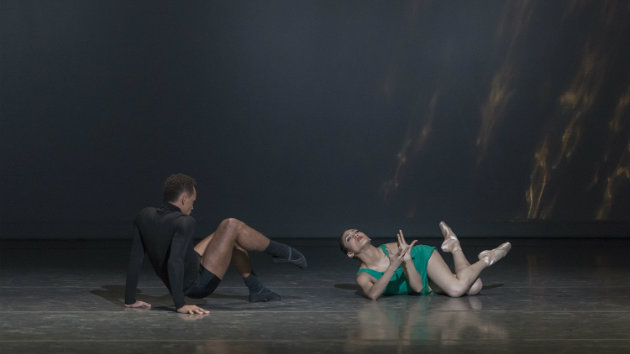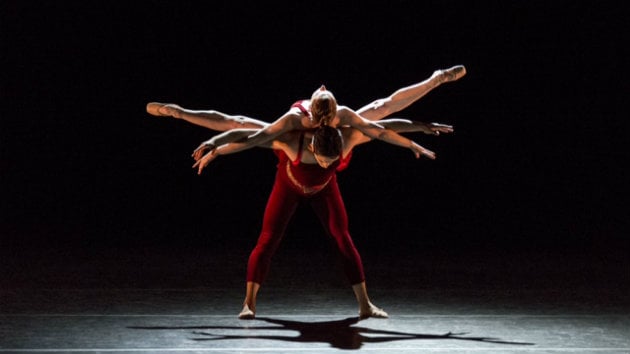
What made Silicon Valley Ballet’s just-concluded tour of Spain a success was warmly displayed Friday night, as the company opened its Director’s Choice weekend of performances at the San Jose Center for the Performing Arts. The company looked daisy-fresh and danced with precision, charm, and confidence in a program of repertory plus just one new thing, an old classical pas de deux called Diana and Acteon.
A love duet for a goddess and a hunter, it was beautifully danced by principals Junna Age, in a short red toga, and Maykel Solas, in a short white one, to music by Cesare Pugni.
Jose Manuel Carreno, the artistic director and thus the Director’s Choice chooser, choreographed it after Marius Petipa. During his career, Carreno also danced (splendidly) in it; you can see it on YouTube.
Carreno’s choreography for both dancers embraces the essential buoyancy and energy of the original. It relies on lovely leg extensions for the ballerina, who rises over and over on pointe into arabesque and attitude, with a sweet little elastic bounce at the most emphatically extended moments. It looks and feels pretty and snappy at the same time, about what you want from a Diana. The other great thing about Ige is her rare and marvelous hang time, that moment of suspension at the apex of grand jetés that are almost as high as she is tall.
Solas’ Acteon zipped through space-devouring leaps with midair beats, air turns, and a fabulous, circling montage of grand jetés. He is also a perfect and adoring partner, and the couple had superb rapport. The arm movements, evoking archery, were the icing on the cake, especially the hunter’s final frieze-like pose, arm drawn back – Acteon, ready for action. For a classical interlude in a contemporary-dance evening, it’s hard to imagine how it could have been better.

Prism, a first viewing for this onlooker, is simply a superb ballet. Choreographed by Annabelle Lopez Ochoa to music by Keith Jarrett, it’s the embodiment of exploration and surprise. The 10 dancers move seamlessly through solos, duos, and trios. The women wear simple yet striking short dresses of bright colors, the men wear bright shirts with their black shorts. It’s an evenly balanced group of five men and five women. Yet the women seem to hold the center of attention in these many-faceted interludes, whether moving independently or with male partners. The coed lifts are sexy and brave; arms and legs are interlaced, bodies intertwined. High-profile female choreographers are still a rarity in dance; Ochoa has all the earmarks. Also terrific is the way her work fulfills the prism motif, subtly morphing from all color to a wash of grey, flattening not only in spectrum, but in style. The dancers sneakily put monotone clothes over their glad rags. Ochoa puts the company into a smooth and seamless rhythmic wash of movement, like the tide coming and greying as the light fails, then turning bright the next morning with the arrival of the sun. Blessed with fine male partnering, the standout women were Amy Marie Briones, Cindy Huang, Junna Ige, Ommi Pipit-Suksun, and Lahna Vanderbush.
Jorma-Elo’s Glow Stop, stunningly presented, is not as compelling as Prism. It suffers from a repetitiveness that even fine performances like Friday’s cannot overcome; it feels overlong and padded. Still, there is beauty in the thematic statements, set to excerpts from Mozart’s Symphony No. 28 and a Philip Glass piano concerto, enacted with propulsive, sleekly muscular splendor by the dozen red-clad dancers.
The much-performed and justly praised Minus 16, choreographed by Ohad Naharin, completed the program.
